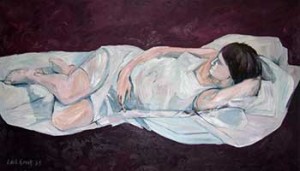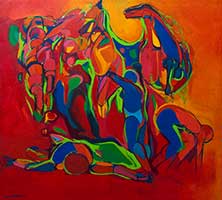The Splendor of Being
/The Splendor of Being
Published by Michael Novak at Patheos.com on March 17, 2015
I've just returned from a wonderful visit at Walsh University in North Canton, OH, where I spoke at the 40th Annual Philosophy/Theology Symposium. In gratitude to my hosts, I would like to post another excerpt adapted from my remarks there. Before I do that, however, let me highlight briefly the thoughtful reception of the concurrent solo exhibition of artwork by my late wife, Karen Laub-Novak. This on the heels of a feature-length article about Karen’s life and work by art historian Gordon Fuglie, Head of Curatorial Affairs for the Central California Museum of Art, in the current issue of Image magazine. On Karen’s work Fuglie commented, “My favorite graphic is the lithograph, ‘Angel of the Second Elegy,’ [Laub-Novak’s] response to the poet Rainer Maria Rilke’s ‘Duino Elegies.’ This is no sweetie-poo Hallmark card angel, but rather possesses something of the majestic terror and awe of the Holy, avoiding literalism and reassuring pictorial attributes.”
Walsh served as the first venue of a traveling exhibition of Karen Laub-Novak’s prints, drawings, and paintings, organized by Fuglie and the Novak estate. For more information, contact gordon.fuglie@charter.net.
* * *
Our tradition teaches us to think of beauty as “the splendor of being.” Why is this? From the point of view solely of nature, that is, what we can know only by unaided human reason, as (let us say) Aristotle did, we can recognize that even the humblest things – a leaf, a snowflake, a single tree in a broad field – stand out from nothingness. These things are here with us, they ex-ist, and the more attention we pay to them, the more radiant in their singularity they become. To exist is not only to be, but always in some way to be beautiful. A singular, unrepeatable existent radiates with flashes of distinctiveness and individuality, its unique form, its own shape, color, and whole panoply of qualities.
For instance, if on a sunlit day on the beach, we put a grain of sand in the palm of our hand and pay attention to it, it becomes marvelous in its colors and its tiny shape. If, on a winter day up north, we pause to attend closely to an individual snowflake that has fallen on the fur cuff of our coat, we can marvel at its own unique and splendid pattern. We can imagine that there’s no other one like it. We can marvel at the incredibly refined detail with which it is wrought.
Normally, for most minds in history, this attention to the fine, intelligent design in all things, even the tiniest ones, has raised heart and mind to the contemplation of the vast power and beauty of the mind that inspired them. Not until the last 200 years did humans imagine that individual beings of such endless beauty could arise from chance, meaninglessness, emptiness, out of nothing. No, intelligence has been exerted, a sense of beauty has been made manifest.
True enough, reason did not always lead men to imagine an almighty, infinite, singular God, a God who is all intelligence, active being, beauty, truth, the good drawing all things unto itself. Not always did the minds of men rise to a personal God. Even less often did the minds of men rise to a God who is creative love, who creates from His own inner love, and who loves each thing that He has created, and in observing it finds it good.
Humans find this out only when the hidden God unveils Himself and makes Himself known through revelation. Even if we do not fully grasp that revelation – “the light shines in darkness, but the darkness grasps it not” (John 1:5) – the beauty and intelligence of everything in creation invite us to believe that what God reveals is true.
Revelation tells us that God is love; and that from the blast of the inner power of His love, He generates a Son; and through their white-hot mutual love, the two generate the spirit of love, the Holy Spirit, the Counselor.
Now let me ask you to do this: ask yourself what, in all the experiences you’ve had, would you identify as the one you cherish most, the one you would like to see expand in your own life, the one that seems most attractive and divine? I am 99 percent certain that you will say it is the experience of love. The love for a guy who loves you, or a girl, the love of your parents, of brothers and sisters, and grandparents, and uncles and aunts. The love between you and your best friend.
Thus it all makes sense. Everything begins in and flows from the love that is God Himself, the love that is so dynamic and in such white-hot heat that it generates another force of love, a living person, and the two of them together generate a third. This Trinity in all its beauty diffuses itself through all creation; it is the goodness that wells up inside all loves, making them to be the keen and powerful energies that they are.
Is that not why we say that beauty is the “splendor of being”? The very source of everything that exists is the God who is constituted by love. Everything that exists radiates love. And it also radiates the brilliant intelligence and proportion and singularity infused in it by its Creator. Radiant indeed! Splendor indeed!
All beauty radiates from the creative love that is the source of all existing things.
All images © Karen Laub-Novak and used with permission.





